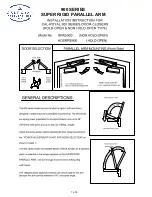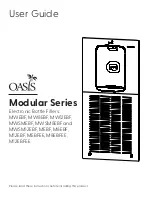
TYPICAL CURRENT RANGES
(1)
FOR TUNGSTEN ELECTRODES
(2)
Tungsten Electrode DCEN (-) DCEP (+) Approximate Argon Gas Flow
TIG TORCH
Diameter in. (mm)
Flow Rate C.F.H. ( l /min.)
Nozzle Size (4), (5)
1%, 2% Thoriated 1%, 2% Thoriated Aluminum
Stainless Steel
Tungsten
Tungsten
.010 (.25) 2-15
(3)
3-8
(2-4)
3-8
(2-4)
#4, #5, #6
0.020
(.50) 5-20
(3)
5-10
(3-5)
5-10
(3-5)
0.040
(1.0) 15-80
(3)
5-10
(3-5)
5-10
(3-5)
1/16
(1.6) 70-150
10-20
5-10
(3-5)
9-13
(4-6)
#5, #6
3/32
(2.4) 150-250
15-30
13-17 (6-8)
11-15
(5-7)
#6, #7, #8
1/8
(3.2)
250-400
25-40
15-23 (7-11)
11-15
(5-7)
5/32
(4.0) 400-500
40-55
21-25
(10-12)
13-17
(6-8)
#8, #10
3/16
(4.8) 500-750
55-80
23-27 (11-13)
18-22
(8-10)
1/4
(6.4)
750-1000
80-125
28-32
(13-15)
23-27
(11-13)
(1) When used with argon gas. The current ranges shown must be reduced when using argon/helium or pure helium shielding gases.
(2) Tungsten electrodes are classified as follows by the American Welding Society (AWS):
Pure
EWP
1% Thoriated
EWTh-1
2% Thoriated
EWTh-2
Though not yet recognized by the AWS, Ceriated Tungsten is now widely accepted as a substitute for 2% Thoriated Tungsten in AC and DC applications.
(3) DCEP is not commonly used in these sizes.
(4) TIG torch nozzle "sizes" are in multiples of 1/16ths of an inch:
# 4 = 1/4 in.
(6 mm)
# 5 = 5/16 in.
(8 mm)
# 6 = 3/8 in.
(10 mm)
# 7 = 7/16 in.
(11 mm)
# 8 = _ in.
(12.5 mm)
#10 = 5/8 in.
(16 mm)
(5) TIG torch nozzles are typically made from alumina ceramic. Special applications may require lava nozzles, which are less prone to breakage, but cannot withstand high temperatures
and high duty cycles.
B-5
OPERATION
B-5
WELDER OPERATION
DUTY CYCLE
Duty Cycle is the percentage of time the load is being
applied in a 10 minute period. For example a 60% duty
cycle, represents 6 minutes of load and 4 minutes of no
load in a 10 minute period.
The RANGER® 305D (CE) can be used with a broad range
of DC stick electrodes. The MODE switch provides two
stick welding settings as follows:
CONSTANT CURRENT (CC-STICK) Welding
The CC-STICK position of the MODE switch is designed for
horizontal and vertical-up welding with all types of elec-
trodes, especially low hydrogen.
The OUTPUT CONTROL dial adjusts the full output range
for stick welding.
The ARC CONTROL dial sets the short circuit current (arc-
force) during stick welding to adjust for a soft or crisp arc.
Increasing the dial from –10 (soft) to +10 (crisp) increases
the short circuit current and prevents sticking of the elec-
trode to the plate while welding. This can also increase
spatter. It is recommended that the ARC CONTROL be set
to the minimum number without electrode sticking. Start
with a setting at 0.
DOWNHILL PIPE (STICK) Welding
The DOWNHILL PIPE position of the MODE switch is a
slope controlled setting intended for "out-of-position" and
"down hill" pipe welding where the operator would like to
control the current level by changing the arc length.
The OUTPUT CONTROL dial adjusts the full output range
for stick welding. The ARC CONTROL dial sets the short
circuit current (arc-force) during stick welding to adjust for
a soft or a more forceful digging arc(crisp). Increasing the
number from –10 (soft) to +10 (crisp) increases the short
circuit current which results in a more forceful digging arc.
Typically a forceful digging arc is preferred for root and hot
passes. A softer arc is preferred for fill and cap passes
where weld puddle control and deposition ("stacking" of
iron) are key to fast travel speeds. It is recommended that
the ARC CONTROL be set initially at 0.
TIG WELDING
The TOUCH START TIG setting of the MODE switch is for
DC TIG (Tungsten Inert Gas) welding. To initiate a weld,
the OUTPUT CONTROL dial is first set to the desired cur-
rent and the tungsten is touched to the work. During the
time the tungsten is touching the work there is very little
voltage or current and, in general, no tungsten contamina-
tion. Then, the tungsten is gently lifted off the work in a
rocking motion, which establishes the arc.
To stop the arc, simply lift the TIG torch away from the
work piece. When the arc voltage reaches approximately
30 volts, the arc will go out and the machine will automati-
cally reset to the touch start current level. The tungsten
may then be retouched to the work piece to restrike the
arc. The arc may also be started and stopped with an
Amptrol or Arc Start Switch. See the following para-
graphs.
RANGER® 305D (CE)
TABLE B.2
Summary of Contents for RANGER 11458
Page 29: ...D 3 MAINTENANCE D 3 RANGER 305D CE ...
Page 39: ...F 1 DIAGRAMS F 1 RANGER 305D CE ...
Page 40: ...F 2 DIAGRAMS F 2 RANGER 305D CE ...
Page 41: ...F 3 DIAGRAMS F 3 RANGER 305D CE ...
Page 42: ...F 4 DIAGRAMS F 4 RANGER 305D CE ...
Page 43: ...F 5 DIAGRAMS F 5 RANGER 305D CE ...
Page 47: ...NOTES RANGER 305D CE ...
Page 48: ...NOTES RANGER 305D CE ...
Page 49: ...NOTES RANGER 305D CE ...
















































